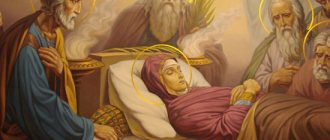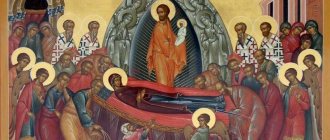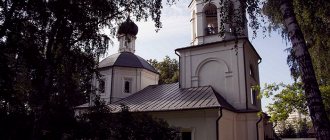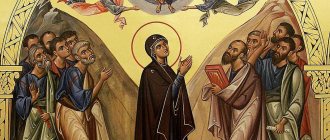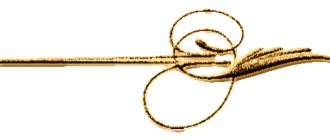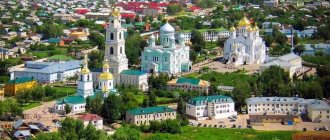Israel Jerusalem
Tomb of the Virgin Mary
- a Christian shrine in the Holy Land, where, according to Holy Tradition, the Most Holy Theotokos was buried by the apostles. Located in Gethsemane, at the foot of the western slope of the Mount of Olives, in the Kidron Valley, in Jerusalem (East Jerusalem). The cave church of the Assumption of the Virgin Mary was built above the tomb. The temple (grotto) is owned by the Greek Orthodox Patriarchate of Jerusalem; The Armenian Church also has the right to use it, and other Christian denominations have access to perform worship.
History[edit]
Burial of the Virgin Mary (Duccio, Maesta, 1308-1311)
According to legend, known since the 4th century, after her Dormition in Jerusalem, the Virgin Mary was buried by the apostles in Gethsemane, in the tomb where her parents, Joachim and Anna, and Joseph the Betrothed were buried. However, the apocryphal “Assumption of Mary” (written no earlier than the 4th century) reports that the Mother of God was buried by the apostles “in Gethsemane in a new tomb.” The Apostle Thomas, who was absent at the burial, came three days later to Gethsemane and asked to open the coffin to say goodbye to Mary; the open coffin turned out to be empty. The tomb of the Mother of God was opened by decision of the Sixth Ecumenical Council, and a belt and burial shrouds were found in it.
History of the Tomb of the Virgin Mary
The first tomb on the mountainside was cut down in the 1st century. AD
In 326, Queen Helena built the first church over the Tomb of the Virgin Mary. The lower part of the church was a cave in the shape of a cross, most of which was carved out of the rock.
This church was destroyed by the Persians in 614, but was soon rebuilt. Pilgrim Arkuf, who visited it in 680, wrote that the church consisted of two levels: in the upper there were 4 altars, in the lower there was one altar and the Tomb of the Virgin.
Church chronicles of the 9th century. It is reported that 13 presbyters and priests, 6 monks and 15 nuns served in the church.
In subsequent centuries, the church was destroyed several times, but the Tomb of the Virgin Mary was not damaged, because Muslims revered it as the tomb of the mother of the Prophet Isa (Jesus), and also because during his Night flight from Mecca to Jerusalem, the Prophet Muhammad saw a light over the Tomb of Mary.
When the Crusaders arrived, the church was in ruins. In 1130, the daughter of Baldwin II Melisende restored the damaged parts of the temple and decorated the walls with red and green frescoes.
A Benedictine monastery with three towers was established near the church to protect the complex. Queen Melisende was buried in the crypt of the upper church in 1161.
After the fall of the Crusaders in 1187, Saladin destroyed most of the structures of the upper church, but did not touch the lower one. After the departure of the Crusaders, the Tomb of the Virgin was looked after by the Franciscans, and now jointly by the Greek, Armenian, Syrian and Coptic Orthodox churches and Muslims.
Plan of the Tomb of the Virgin Mary
The temple belongs to the Greeks and Armenians. It is here, according to tradition, before the Feast of the Dormition from Little Gethsemane near the Church of the Holy Sepulcher that the Orthodox carry the Shroud of the Most Holy Theotokos in a procession along the same path as the apostles once carried the body of the Mother of God to burial.
Description[edit]
The temple is located underground, the entrance to it is from the south. A wide stone staircase of 48 steps leads down from the entrance. The underground church is shaped like a cross and contains a marble edicule (that is, a small chapel, just over 2 x 2 m) with the tomb of the Virgin Mary. The Edicule has two entrances, one from the west, the second from the north. Usually pilgrims enter through the western entrance and exit through the northern entrance. Behind the cuvuklia, in the eastern part of the temple, is the miraculous and highly revered Jerusalem Icon of the Mother of God of Russian writing, which is placed in a pink marble icon case[4]. To the left of it, near the wall, is an Orthodox altar. On the southern side of the edicule there is a small prayer house for Muslims who also venerate the Virgin Mary.[5]
The main volume of the temple measures approximately 34 m in length from east to west and 6 m in width from north to south. The staircase leading to the temple is approximately 6.5 m wide.
Thrones of the lower tier
There are at least nine chapels and altars in the temple. Funeral services of all Christian denominations are held here, only Catholic and Protestant churches are excluded. Main thrones:
- Orthodox, considered the main one - located only half a meter above the tomb of the Mother of God. Recently, Armenians also received the right to hold services near this throne. This is the chapel of Saints Joachim and Anna, St. First Martyr Stephen, St. Nicholas the Wonderworker;
- Armenian - it has been at the disposal of believers since 1814. This is the throne of honor of the righteous I. Betrothed;
- Syriac Orthodox Church - near the exit to the north from the edicule;
- Christian Church of Egypt - in the western part of the temple.
Where to stay[edit]
- Pilgrimage houses of the Gornensky Monastery
Pilgrims arriving at the Gornensky Monastery are accommodated in small pilgrimage houses located on the territory of the monastery. Currently, the Gornensky Monastery has 4 pilgrim houses, with a capacity of 10 to 22 people. Settlement in the pilgrimage houses of the Gornensky convent in Jerusalem is carried out through the Pilgrimage Service of the Russian Spiritual Mission.
The pilgrim houses have a kitchen where pilgrims can prepare tea (pilgrims eat in the monastery refectory); shower and toilet are on the floor.
Address:
Israel, Jerusalem, Ein Karem
Directions:
A pilgrim going to the Gornensky Monastery only needs to have a foreign passport and an air ticket for a flight to Ben Gurion Airport. From there, buses, trains and taxis go to Jerusalem; the journey takes about an hour. From the center of Jerusalem (Old City) the monastery in Gorny can be reached by bus routes 19 and 27 (stop “Hadassah Hospital”).
Messenger of God
As legends tell, one day Archangel Gabriel, the guardian of the divine treasury, descended to earth. God himself entrusted him with an important mission: to talk with the chaste girl Maria, who from childhood grew up surrounded by deeply religious people serving God. During his visit to earth, the Archangel had to ask Mary's permission if she agreed to bear and give birth to a divine child who would save humanity.
The girl at that time was engaged to Joseph, an elderly Christian who certainly believed in God. Joseph, asking for her hand in marriage, promised to treat the girl like a daughter, not touching her integrity, understanding her choice to serve God and supporting her.
When Gabriel began to tell Mary about the divine plan, the girl silently listened to him and courageously accepted the Archangel’s offer, humbly, without fear or doubt, entrusting her fate into the hands of God. Thanks to her upbringing and genetics, embedded in her over generations, she had exceptional purity of thoughts. Raised in a family of saints and brought up according to biblical laws, and from the age of three living in a monastery, Mary did not cloud her mind with pride because of the new status of the Mother of God, she remained a sane, pious, spiritual girl, who, together with her husband Joseph, raised a beautiful son, Jesus - Savior.
Finding the relics of the Virgin Mary
The history of the Blessed Virgin Queen of Heavenly Mary after the crucifixion of her son the Lord Jesus Christ has been covered in the darkness of ignorance until now.
Today I can talk about the last years of the life of the Mother of God and the burial place of her mortal body. After the Ascension of Jesus Christ, and in fact his retirement from affairs within the Roman Empire in 1010, the Mother of God moved to live in the city of Ephesus (in modern Turkey). From time to time she visited her palace in Blachernae, Constantinople, which she inherited from her mother, the Byzantine princess Anna, sister of Emperor Constantine. The Queen of Heaven traveled a lot, visited Mount Athos and Cyprus. The Mother of God was always accompanied by John the Theologian. The Byzantine emperors from the Idol family were removed from power in the empire, so persecution of Christians began by the newly-minted emperors. In 1024, it was decided to hold the rite of the Dormition of the Virgin Mary to protect against the threat of reprisals. The Lord has always believed that everyone who wants glory should be able to say goodbye with honor in time and know the difficult art of leaving. The ceremony was held in Constantinople in the presence of the apostles, and Jesus Christ arrived there from Pakistan. At the third hour of the Assumption ceremony, Chrysostom himself appeared in the room in the rays of heavenly glory. The Mother of God rose from her bed and bowed to her son. Without any bodily suffering, as if in a pleasant dream, the Most Holy Virgin handed over her soul to Jesus Christ Chrysostom and God.
When the funeral procession went to the burial place of the Mother of God, it was attacked by Jewish clergy and soldiers, trying to stop the ritual and burn the body of the Mother of God at the stake. Rabbi Afoniy especially distinguished himself by trying to overturn the bed of the Mother of God with his hands. Something cut off his hands, and a wonderful light covered the procession, making it invisible to his pursuers. The sleeping body of the Mother of God was placed in a stone coffin, or rather a cave, the entrance to which was blocked with a huge stone. On the third day, the “unbeliever” Apostle Thomas appeared and asked to open the coffin in order to say goodbye to the Mother of God. There was no one in the coffin, only fragrant shrouds. These vestments were given to the Empress Saint Pulcheria in Constantinople and placed in the Blachernae Temple.
That same day in the evening, when the apostles gathered in the house to refresh themselves with food, the Mother of God appeared to them and said: “Rejoice! I am with you all the days." This made the apostles and everyone with them so happy that they raised part of the bread supplied for the meal in memory of the Savior (“part of the Lord”) and exclaimed: “Most Holy Theotokos, help us.” This marked the beginning of the rite of offering panagia - the custom of offering part of the bread in honor of the Mother of God, which is still preserved in monasteries. Alive and healthy, the Mother of God moved to live in the Apennines. She made her residence a house in the small town of Loreto, near the city of Ancona, in Dalmatia, on the Adriatic coast. Apparently, she traveled a lot and visited northern Italy, the Cote d'Azur of France, and Spain. She met with the Apostle Peter, who founded the papal throne, became the first pope of the Catholic Church and settled on the site of the ancient Etruscan city, which is called today “Western” Rome.
The Madonna of Loretto (Virgin Mary and baby on the roof of the house) has been known since the 13th century. The image of the Virgin Mary and Child on the roof of a house, lifted into the air by angels who support each of its four corners, illustrates the legend concerning the shrine at Loreto. It tells how the "Santa Casa" - the home of Mary and Joseph in Nazareth, the same one to which the angel of the Annunciation came - was carried to safety by angels in 1291, when the Saracens drove the Crusaders from the Holy Land. At first, the angels moved it to the coast of Dalmatia, but Loreto, a town near Ancona, became its permanent place. According to the official version, this legend was born in Italy in the 15th century and was used by the Jesuits from the end of the 16th century to turn this city into a center of pilgrimage. In fact, information has been preserved that the Mother of God lived in this house in the 11th century, but in the 16th century, a new chronology of Scaliger was established in Catholicism, and biblical events were pushed back 1000 years from the true dates. As a result, real biblical events had to be clothed in legend, and the real house of the Virgin Mary had to be turned into a copy of the house from Nazareth.
For secrecy, the Mother of God apparently changed her name and began to be called Queen Juliana or Juliana. In this capacity, she sometimes visited her palace in Constantinople. At the end of her earthly life, the Queen of Heaven decided to build the Church of the Assumption in Kyiv and there forever preserve her mortal body in a coffin.
To carry out the planned plan, the Mother of God arrived in Constantinople in the early 50s of the 11th century, where the following events took place, known from the book “Paterik of the Pechersk or Fatherland” of 1902, republished in 2002 by the printing house of the Kiev-Pechersk Lavra in Kyiv. They are given in “The Legend of the Holy Miracle-Working Pechersk Stone Church of the Assumption of the Blessed Virgin Mary,” pp. 118 – 137, written by Bishop Simon.
According to Simon, a few years after the Varangian Shimon Africanus presented the personal belongings of Jesus Christ - a crown and a belt - to St. Anthony, the founder of the Kiev Pechersk Lavra, four architects from Constantinople appeared in Kiev. The crown was supposed to be placed above the altar of the future church, and the belt was supposed to become a measure of length for the builders. The size of the church was supposed to be twenty belts wide, thirty long and fifty high. Shimon kept the crown and belt for many years, and the Lord protected the Varangian during numerous battles and engagements. After all, these relics for the future Church of the Mother of God in Kyiv were given to Shimon in Constantinople before his crucifixion by Jesus Christ himself.
The architects met in Kiev with the Monks Anthony and Theodosius in the Lavra and told them the following story (I will give it in detail): One morning, when we were sleeping in our houses, at sunrise handsome young men came to each of us, saying: “The Queen is calling you in Blacherna." We went, taking our friends and relatives with us, and met in Blachernae, arriving all at the same time. We saw the Queen and many warriors around her and bowed to her. And she told us: “I want to build a church for myself in Rus', in Kyiv; I command you to take three years’ worth of gold with you and go build it.” We, bowing, said to her: “Oh, Lady Queen, you are sending us to a foreign country, to whom are we going there?” She said: “I am sending the upcoming ones here, Anthony and Theodosius.” We asked: “You give us gold for three years, Lady; so tell them that we have food and everything we need. You yourself know what to reward us with.” The queen said: “This Anthony will only bless you for your work, and he himself will go to eternal rest. Theodosius will follow him in the second year. So, take the gold until you have enough and go. And no one can reward like me. I will give you what eye has not seen, what ear has not heard, what does not enter the heart of man (1 Cor. 2:9). I’ll come to see the church myself and I want to live in it.”
She also gave us the relics of the holy martyrs Artemios, Polyeuctus, Leontius, Akakios, Arethas, Jacob, Theodore, saying: “Put this in the foundation of the church.” We, taking the holy relics, gold and other things we needed, asked the queen about the size of the church. And she told us: “I sent my son’s belt according to his command; but go out into the open and you will see its size.” We went out and saw the church in the air, and when we returned, we bowed again to the queen and asked: “Madam, in whose name will the church be?” She said: “I want to name her after me.” We didn't dare ask her what her name was. The queen herself said: “The Church will be the Mother of God.” And she gave us this holy icon, saying: “Let her be the Viceroy!” We worshiped and went to our homes, having with us this icon, which we accepted from the hands of the queen.
The architects told the monks Anthony and Theodosius that they escorted them to the ship, and after staying at home for one month after the monks’ departure, they set off from Constantinople and arrived in Kyiv on the tenth day. The Monk Anthony answered the masters: “Children, we never came to you from this place.” Then: “Oh, children, Christ has vouchsafed you great graces, because you are the doers of his will. Those handsome young men who called you are bright Angels, and the Queen in Blachernae appeared to you, apparently, our Most Holy, Pure and Immaculate Lady, Theotokos and Ever-Virgin Mary. And the warriors who surrounded her are also ethereal Angelic Forces. Regarding our similarity and the gift of gold to you, God alone knows what he did with his slaves. Blessed is your coming, and your kind companion is with you - this honest icon of the Lady Theotokos: She will give you, as promised, what the eye has not seen, and the ear has not heard, and what has not entered the human heart (1 Cor. 2:9) . For no one can give this, only she herself and her son, the Lord God and our Savior Jesus Christ, whose belt and crown were brought here by the Varangian, and the measure of the width, length and height of that most pure church was spoken about from heaven, from magnificent glory, voice to Simon the Varangian, who gave us this belt.”
Thus, the abbots of the Lavra turned this real story into a legend and a miracle. However, the Mother of God personally presented the craftsmen, in the presence of her friends Anthony and Theodosius, with gold, an icon, and the relics of saints, gave a plan for the church and instructed them to carry out a complex order in her homeland, in Rus'. She also clearly and unequivocally stated that she was going to find peace in the new Church of the Assumption of the Virgin Mary. According to the official chronicle of Nestor, construction of the Church of the Dormition of the Virgin began only in 1073, then, a few years later, eight icon painters from Constantinople arrived, also paid in advance in gold for painting the temple and teaching icon painting to Russian masters.
It is believed that the Church was completed and consecrated on August 14, 1089. In fact, I believe that these events took place 20 years earlier. Construction of the church began in 1051–1053 and was completed in 1069. Its foundation and walls were erected within three years from the start of construction. The painting of the temple began 10 years after the start of construction.
Obviously, during the construction of the temple, the Queen of Heaven ended her earthly journey and died in Loreto somewhere in the mid-60s of the 11th century. The body of the Blessed Virgin was dressed in royal clothes and jewelry, placed in a special coffin, on which only the name was written - Queen (Princess) Juliana or Julia. Then the coffin was sent by sea to Kyiv. The remains of the Mother of God were buried in a Roman coffin, apparently made of marble, near the wall of the Church of the Assumption of the Mother of God in front of the border of St. John the Baptist.
For many centuries, the body of the Queen of Heaven lay in peace in a place determined by the Mother of God herself. The 17th century came, a time of rampant unrest in Rus', caused by the actions of the criminal Tsar Ivan the Terrible and the mistakes of the Orthodox Church. Less than 600 years have passed since the burial of the Blessed Virgin.
Further events are described in the book mentioned above, in the chapter “The Legend of the Finding of the Honorable Relics of St. Juliana the Virgin,” pp. 337 – 340. I will immediately note that the Pechersk Lavra was a monastery. The official church version is intended to eliminate the misunderstanding and strangeness of finding the coffin of an unknown virgin. Around 1617, during the days of Archimandrite Elisha Pletetsky of the Pechersk Lavra, a certain virgin died in Kyiv, and it seemed they had decided to bury her in the Pechersk Monastery. “They began to dig a coffin near the Pechersk Church of the Assumption of the Blessed Virgin Mary, in front of the border of St. John the Baptist. And so the diggers unexpectedly found the honest relics of the holy, God-pleasing Princess Juliana, venerated in incorruption. The deceased lay as if she were alive and asleep; her body was beautiful and white. The deceased was dressed in valuable clothes, decorated with silk and gold woven overlays; on the neck there are golden hryvnias with many beads, on the hands there are golden precious rings, on the head there is a girl’s golden crown with beads; There were gold earrings in the ears, decorated with gold beads and precious stones. She lay against the church wall, with her head to the south and her feet to the north... All her clothes seemed completely new, as if no one had touched them.”
But as soon as they touched her clothes, they crumbled into dust. All that was left was her incorruptible body, which death seemed not to dare to touch, and also the precious jewelry on her hands. The holy maiden was dressed in new clothes and laid in the southwestern corner of the Great Assumption Church, but without the honors due to saints. Obviously, Archimandrite Elisha Pletetsky was horrified - where did the coffin of a virgin come from in the monastery? I believe that such a way out of the scandalous situation was found. The deceased was ranked among the family of the Olshansky princes, because she was the deceased daughter of the last prince Gregory of Olshansky, who was a benefactor of the Pechersk Lavra about 60 years ago. It was officially announced that a sign was found next to the coffin, on which it was written: “Iuliania, Princess Olshanskaya, daughter of Prince Gregory of Olshansky, who introduced herself as a maiden, and the 16th summer from her birth.” This idea is understandable, because no one except the Olshansky princes called their girls Iulian (Ulyan). If we see a forgery in the actions of Archimandrite Elisha Pletetsky, then it must be said that it was carried out with amazing precision and scope. In those days, people knew nothing about genes and DNA, but they understood whose blood flowed in their veins. After all, all the Olshansky princes in the female line had the genes of the Most Holy Theotokos. In 1349, Princess Ulyana (Iuliania) Alexandrovna Tverskaya, daughter of Alexander Mikhailovich Monomashich Rurikovich, descended from Vsevolod the Big Nest, son of Yuri Dolgoruky and Olga, daughter of the Byzantine Emperor John Komnenos, was married to the founder of the dynasty, Grand Duke Olgerd. Vsevolod the Big Nest himself was the son of Vladimir Monomakh, the grandson of the Savior and the great-grandson of the Mother of God. Therefore, a DNA analysis of the honest relics of Saint Juliana will clearly show the presence of the genes of the Rurikovichs and the Mother of God herself.
Catholics and Masons from Europe learned about the amazing discovery in the Lavra.
In 1617, a certain man came to the monastery - no one knew who he was. As it turned out later, it was a heretic, a follower of Arius, named Vasily. “Pretending to be a believer and taking on the appearance of reverence, he came to the monastery, as if with the goal of visiting holy places and venerating the miraculous relics of the holy Pechersk saints. He boldly entered the great Pechersk Church. Hiding his cunning, he turned to Deacon Liverius, then ecclesiarch, with a request to open the shrine of the blessed Princess Juliana to him. The hypocritical stranger expressed a desire to venerate those relics. His request was fulfilled; he began to bow hypocritically. But the ecclesiarch left for a while. The disgusting flatterer then decided to carry out his plans. Having approached the honorable relics of Saint Juliana and, as if kissing them diligently, he managed to remove the precious ring from the finger of the holy princess’s right hand. Having committed the theft and rejoicing at the acquisition, the thief began to leave the church. As soon as he stepped outside the church door, he suddenly became furious; he fell on a stone and began to scream like a raging ox, and painfully rushed in all directions. In such torment, the blasphemer soon gave up the ghost... Wanting to find out the reason for this event, the abbot ordered a careful examination of the deceased to see if there were any stolen church items with him. They examined him and found a ring in his bosom.”
The ring turned out to be from the shrine of Juliana. It was placed next to the icon of the Most Holy Theotokos among other sacred utensils. The saint was buried outside the monastery. A little time passed, and Peter Mogila became Metropolitan of Kyiv and Archimandrite of Pechersk. He said that “the holy, God-pleasing princess Juliana appeared to him in a miraculous vision, denouncing him for the neglect of her holy relics and for his lack of faith in them (after the discovery of the relics, they were left without worthy decoration, they were not given honor). Then the shepherd immediately ordered the skilled and pious virgins of the monastic order to prepare worthy robes and beautiful utensils for the holy relics. By his order, a new shrine was also made, into which the holy relics were placed in an orderly manner; they were solemnly transferred to another place. Having donned holy robes and convened the entire consecrated cathedral, Peter Mogila performed festive prayer and singing, with thanksgiving to God and the Mother of God and the venerable fathers of Pechersk for the revelation of the holy relics of the holy virgin.”
At that time, an inscription was made on the saint’s tomb: “By the will of the Creator of heaven and earth, Juliana, the helper and great intercessor in Heaven, lives throughout the years. Here bones are a medicine against all suffering... You adorn the villages of paradise with yourself, Juliania, like a beautiful flower..."
One day the holy virgin Juliana appeared to the abbot of the Kyiv St. Michael's Monastery, Theodosius Safonovich. The abbot had a vision. After the morning singing and leaving the church, he fell asleep, and in a dream the faces of many holy virgins appeared to him in a radiant light. One of them told him: “I am Juliana, whose relics lie in the Pechersk Church. Why do you count me and my relics as nothing? For this reason, the Lord showed you a sign, so that you would understand that the Lord God also counted me among the holy virgins who pleased Him.” Since then, Saint Juliana has become even more venerated. Hegumen Theodosius never forgot to venerate piously, with all zeal, with humility and a tender kiss to the incorruptible relics of the holy saint Juliana.
However, the relics of the unknown Saint Juliana apparently irritated many monks and monastery leaders. After all, no one has yet found documentary evidence of the existence of Princess Juliana Olshanskaya, daughter of Prince Gregory of Olshansky. And the miraculous appearances of the saint evoked mixed feelings among the Lavra brethren.
I cannot call the tragedy that unfolded later in the Church of the Assumption of the Blessed Virgin Mary accidental. In 1718, the relics of the saint burned in a fire in the church. The remains of the relics were placed in a new reliquary and placed in the Near Caves of the Kiev Pechersk Lavra, where they are still kept. The holy righteous virgin Juliana became the second of the holy wives of Rus' who were honored to be buried in the Near Lavra caves. In 1889, at the request of Archbishop Modest of Volyn, part of the holy relics was transferred to the Cathedral of Zhitomir. There is a particle of relics in the church in Golshany, the family nest of the Olshansky princes. It is believed that this saint is the first helper to women in healing diseases of the soul. She stands for them, together with our other saints, before the Most Pure Mother of the Lord and, together with Her, before the Throne of the Holy Trinity. She is also the intercessor of innocent virgins.
On the icons, Saint Juliana is depicted in the Cathedral of the Holy Fathers of the Kiev Pechersk Lavra. The saint's memorial days are July 6 and September 28. On icons, Saint Juliana is depicted with a shock of white hair. However, she is not blonde, but completely gray. This mysterious story from the 16th century to the 18th century took place in the Church of the Assumption of the Virgin Mary in the Pechersk Lavra. However, everything secret becomes clear. A lie cannot live forever.
The Most Holy Queen of Heaven found her peace within the confines of her Church of the Assumption of the Virgin Mary in the Pechersk Lavra. She herself ordered the construction of the temple, paid for the work of the builders and icon painters, proposed a construction project, and gave the architects holy relics and her icon. After her earthly death at the beginning of the second half of the 11th century, her incorruptible body was transferred to Kyiv and buried in her eternal home. The rest of the Virgin Mary lasted only about 550 years.
In 1617, her coffin was opened by the monks of the Pechersk Lavra, disturbing the peace of her incorruptible body, and destroying the funeral clothes of the Queen of Heaven. For a hundred years, the remains were treated without due respect and respect, they lay without proper piety within the church. To prevent the desecration of the grave, the Mother of God herself had to punish the thief of her ring with death. The blasphemer was one of the heretics - the Arians. It is obvious that he was sent by the Freemasons of the West to deliver to them a personal item of the Virgin Mary. They apparently were aware of whose body was found in the Lavra in 1617.
How can you not guess? They found the incorrupt body of a woman who had been a virgin all her life, so she was buried in the attire of a virgin. Over the course of a hundred years of her life, her hair had completely turned gray, and her body was young, because... she was God's chosen one, the Queen of Heaven. Old age only touched her hair. The princess was laid in a coffin wearing imperial jewelry. On the coffin, apparently made of marble by Italian craftsmen, there was an inscription that said that Princess Juliana, or Julia, was buried in it. This was the name of the Queen of Heaven in Dalmatia, Italy. The clothes of the Virgin Mary crumbled into dust, since the age of the fabric was about 550 years, and they lay underground. After the discovery of her relics, the Mother of God appeared in a dream to the archimandrites of the Pechersk Lavra, but they were afraid to admit it and talked about the appearance of Saint Juliana, since they could not imagine that this was the body of the Mother of God herself. After all, they were sure that the Mother of God lived 1700 years before their time and the body of the Queen of Heaven disappeared from the tomb after her Dormition. The lies of Scaligerian chronology and the machinations of the Catholic Church, Jewish theologians and Masonic historians have done their job. Lies have become stronger in Orthodoxy. Orthodox people and the priesthood could not accept and understand the fact that the Mother of God was a Russian Varangian from the Rurik family and a princess, the daughter of Grand Duke Vladimir the Red Sun and the Byzantine princess Anna. They also did not understand why the Mother of God declared that she was the patroness of Rus', because she cared about her homeland. The desire of the Mother of God to find earthly peace in her homeland, on the land of her father - in Kiev, in her own Church of the Dormition of the Mother of God in Pechersk Lavra.
The unknown origin of the coffin and the miracles performed by Juliana led to mistrust among the monks. The result was the greatest blasphemy in the history of Christianity. The incorrupt body of the Mother of God was exposed to fire. A fire in 1718 caused irreparable damage to the remains of the Blessed Virgin Mary. What the rabbis led by Athos in Constantinople, who wanted to burn the body of the Mother of God, could not do in 1024, was accomplished by sinners and blasphemers in Kyiv 700 years later. After the fire, the body of the Blessed Virgin Mary, Queen of Heaven, was transferred from the church to the Lower Caves, which once again violated the will of the Mother of God. With the Bolsheviks coming to power in 1917, the crimes continued. In 1941, the ancient Pechersk Church of the Assumption of the Virgin Mary was blown up, and the icon of the Mother of God, the vicar of the temple, disappeared (perhaps it was stolen).
Notes
- [www.krotov.info/acts/01/joseph/apok_41.html Assumption of Mary]
- [www.catholicity.com/encyclopedia/m/mary,tomb_of_blessed_virgin.html Tomb of the Blessed Virgin Mary] (English)
- [www.pravoslavie.ru/orthodoxchurches/40826.htm Church of the Assumption and the tomb of the Virgin Mary in Gethsemane]
- ↑ 1 2 Holy Land.
Historical guide to memorable places in Israel, Egypt, Jordan and Lebanon. / Ed. M. V. Bibikov. M., 2000, p.66 - ↑ 1 2 3 4 5 6
Archimandrite Leonid Kavelin.
Old Jerusalem and its surroundings.
From the notes of a monk-pilgrim. M.: Indrik, 2008. p.186-190 - [www.xxc.ru/orthodox/pastor/uspenie/s1.htm Holiday in Jerusalem]
- [lib.pushkinskijdom.ru/Default.aspx?tabid=4934 Life and walk of Abbot Daniel from the Russian Land
]
Birth of the Son of God
Ancient Jerusalem at that time was under the rule of the Roman Empire, led by Octavian. He proposed organizing a population census. The closest town from Israel where Joseph and Mary could be registered for inclusion in the list was the blessed city of Bethlehem. When the couple finally reached the city, they could not find a single free room in a tavern, hotel or inn. They had to settle down for the night in a barn.
Maria was in her last month of pregnancy. The long journey did its job: the girl went into labor, and baby Jesus was born. Then an angel descended from heaven and announced to people that the son of God had been born, and that he would save humanity from death.
The first to bow to the newborn savior were the shepherds. Following them, wise men from the East, the Magi, appeared and brought their gifts. The wise men found the child by a star that appeared directly above the birthplace of Jesus. They recognized him as a King, God and a mortal man, and presented him with appropriate gifts: gold, incense and myrrh.
